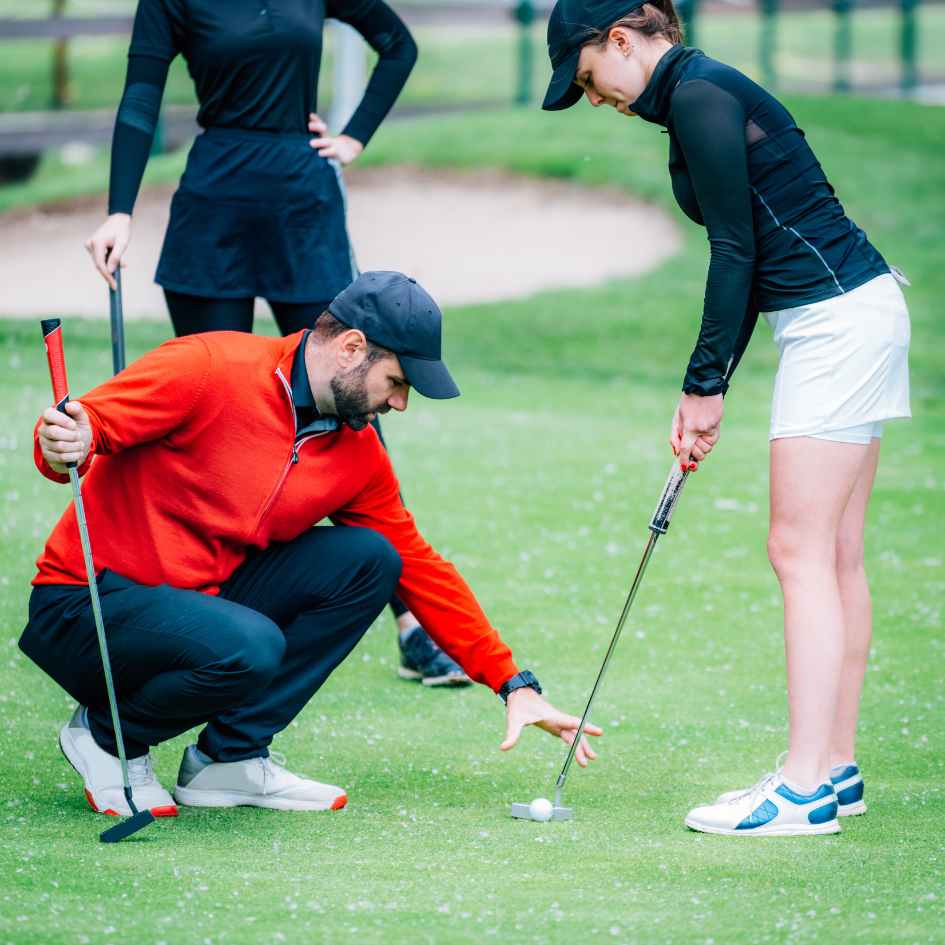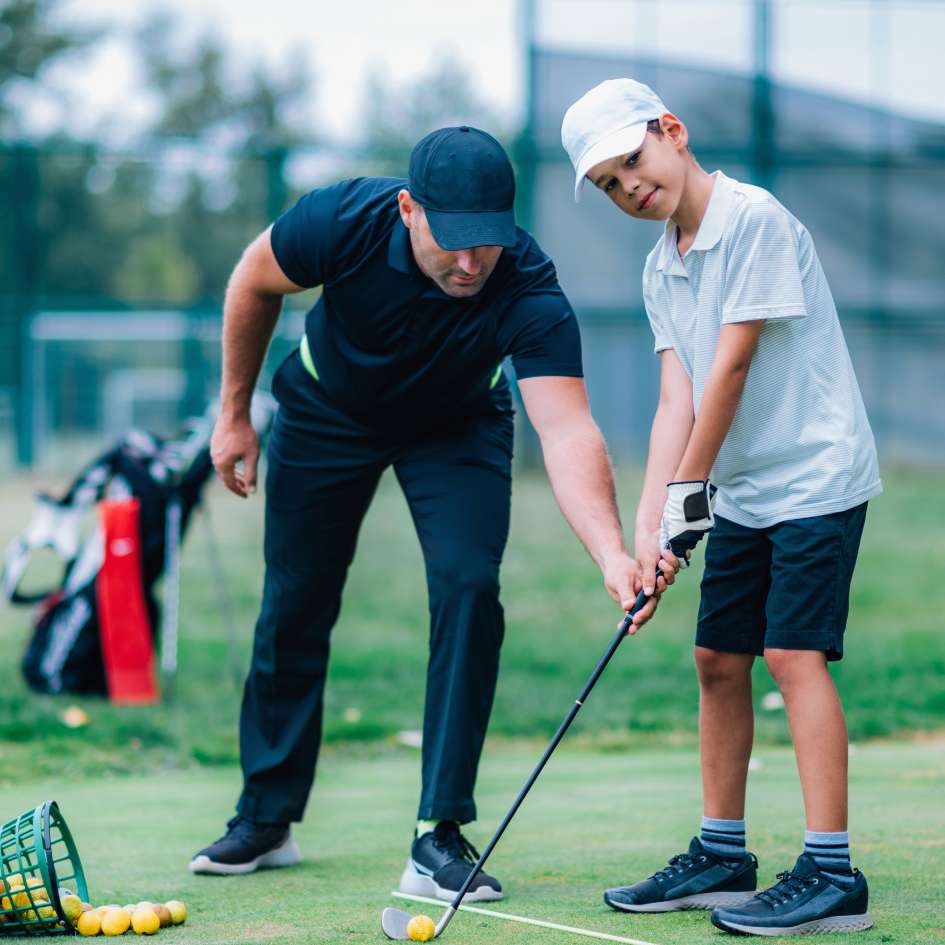
25 Best Golf Tips for Beginners
25 Best Golf Tips for Beginners
Mastering the Greens: In-Depth Best Golf Tips for Beginners
Embarking on your golfing journey? Golf For Beginners Academy has you covered with a detailed guide featuring essential tips tailored for novice players. Let’s dive into each section for a comprehensive understanding of golf tips for beginners.
The Fundamentals of Golf - Section 1
Proper Grip and Stance: Achieve a strong foundation by mastering your grip and stance. A neutral grip and balanced stance provide stability, ensuring a controlled and powerful swing.
Understanding Club Selection: Learn the basics of club selection based on the distance and shot requirements. Familiarize yourself with the different types of clubs and their specific uses.
Swing Basics: Focus on a fluid and balanced swing. Practice your backswing, downswing, and follow-through to create a consistent and efficient motion that improves accuracy.
Ball Positioning: Understand the importance of proper ball positioning for different shots. Master the alignment of the ball in your stance to optimize trajectory and contact.
Developing a Pre-Shot Routine: Establish a pre-shot routine to enhance your focus and consistency. This routine can include visualizing your shot, checking alignment, and taking a few practice swings.

Want to learn more about the swing?
Listen to our podcast!
Mastering the Short Game - Section 2

Putting Precision: Hone your putting skills by focusing on distance control, alignment, and a smooth stroke. The short game is often where strokes can be saved or lost.
Chipping Techniques: Practice various chipping techniques for shots around the green. Learn how to control trajectory and spin to get the ball close to the hole.
Pitching Perfection: Develop your pitching skills for shots that require more loft. Mastering the pitch shot is crucial for navigating obstacles and landing the ball softly on the green.
Bunker Play: Understand the fundamentals of bunker play, including the proper setup, swing, and strategy for getting out of sand traps efficiently.
Reading Greens: Improve your ability to read greens by understanding the slope, grain, and nuances of the putting surface. Accurate green reading is key to successful putting.
Course Management Strategies - Section 3
Playing Within Your Abilities: Recognize your skill level and play within your abilities. Avoid unnecessary risks and focus on making consistent shots to improve overall performance.
Strategic Club Choices: Develop a strategic approach to club selection based on the layout of the course. Choose clubs that allow you to navigate hazards and position yourself for the next shot.
Understanding Par: Familiarize yourself with the concept of par and set realistic expectations. Aim to play within or slightly above par, focusing on steady improvement.
Pace of Play: Respect the pace of play on the course. Be mindful of your group’s speed, maintain a reasonable pace, and be ready for your turn to keep the game enjoyable for everyone.
Course Awareness: Stay aware of the course layout and potential challenges. Knowing where hazards, bunkers, and doglegs are located helps you plan and execute more successful shots.

Mental Game and Focus - Section 4

Maintaining a Positive Mindset: Cultivate a positive attitude on the course. Overcome challenges with resilience, focusing on learning from each shot rather than dwelling on mistakes.
Visualization Techniques: Harness the power of visualization to enhance your performance. Picture successful shots in your mind before executing them to boost confidence.
Breathing and Relaxation: Incorporate deep breathing and relaxation techniques to stay calm under pressure. Managing stress enhances your ability to make clear decisions on the course.
Handling Setbacks: Learn to bounce back from setbacks and mistakes. Resilience is a crucial trait in golf, and the ability to recover from a bad shot is essential for long-term success.
Staying Present on the Course: Practice staying in the moment during your round. Avoid dwelling on past shots or worrying about future ones. Focus on the task at hand to improve overall performance.
Continuous Improvement and Resources - Section 5
Effective Practice Habits: Maximize your practice sessions with focused drills and exercises. Target specific areas of your game that need improvement and track your progress over time.
Golf Lessons and Professional Guidance: Consider taking golf lessons from a certified instructor. Professional guidance helps identify areas for improvement and provides personalized feedback.
Utilizing Technology: Leverage golf technology, such as swing analysis apps and launch monitors, to gain insights into your swing mechanics and track performance metrics.
Joining a Golf Community: Connect with other golf enthusiasts by joining a local golf community or club. Networking with fellow players provides opportunities for friendly competition and shared learning.
Staying Informed: Stay informed about the latest trends, techniques, and equipment in the golfing world. Subscribe to golf publications, follow reputable online resources, and attend golf expos for continuous learning.

Ready to Take the Next Step? ⛳️
If you’re eager to dive deeper into golf’s intriguing world and master the ins and outs of the game, look no further than our “Golf For Beginners – The Ultimate Starter Guide.” Whether you’re a newbie or just brushing up on your skills, this online course has something for everyone.
⛳️ Discover the Ultimate Golf Starter Guide Right Here ⛳️
Conclusion on the 25 Best Golf tips for beginners
Congratulations! You’ve navigated through our comprehensive guide on golf tips for beginners. Remember, mastering golf is a continuous journey of improvement. Apply these tips, stay dedicated to your practice, and enjoy the evolving experience of becoming a skilled and confident golfer. Golf For Beginners Academy is here to support you every step of the way. Happy golfing!
Did You Like The 25 Best Golf Tips For Beginners?
If you want more detailed help with you game of golf, and specifically about the short game of golf, our partner-portal called World Of Short Game deliver great content for all short game related topics. Click here to visit World Of Short Game.
And if you live in Denmark, never hesitated to reach out to Danish Golf Academy for help with any part of your game.

9 Essential Golf Putting Tips for Beginners
9 Essential Golf Putting Tips for Beginners
Perfecting Your Putting as a Beginner
Welcome to Golf For Beginners Academy, where we guide novice players through the basics of golf. Today, we’re focusing on an integral aspect of the game – putting. For beginners, mastering the putt is key to lowering scores and enjoying the game to the fullest. Let’s delve into essential golf putting tips tailored just for you.
Golf Putting Tips for Beginners
Grip and Stance: Start with a comfortable grip, neither too tight nor too loose. Adopt a shoulder-width stance for stability. This sets the foundation for a controlled and consistent putting stroke.
Eye Alignment: Ensure your eyes are directly over the ball. This alignment enhances your perception of the putting line and helps you visualize the correct path to the hole.
Smooth Putting Stroke: Develop a smooth, pendulum-like putting stroke. Avoid unnecessary wrist movements and let the shoulders control the motion. A steady stroke promotes accuracy and distance control.
Distance Control: Mastering distance control is crucial. Spend time practicing putts of various lengths to develop a feel for the required strength. Consistent distance control is a game-changer on the green.
Read the Green: Analyze the slope and break of the green before making your putt. Look for subtle undulations that can influence the ball’s path. Reading the green is a skill that improves with practice and observation.
Practice Putting Drills: Incorporate putting drills into your practice routine. Focus on short putts to build confidence and gradually extend the distance as your skills improve. Consistent practice hones your putting prowess. Check out this article for our favorite putting-drills for beginners!
Putter Choice: Experiment with different putters to find one that feels comfortable for you. The right putter can enhance your control and confidence on the green. Consider seeking advice from a golf professional to find the perfect fit.
Maintain a Routine: Develop a pre-putt routine to create consistency in your setup and stroke. This routine could include a few practice swings, checking the line, and aligning the putter face to your intended target.
Stay Calm Under Pressure: Putting often determines the outcome of a hole. Practice keeping a calm mindset, especially when facing pressure situations. Relax, trust your skills, and execute your stroke with confidence.
Listen to a deeper explanation on our Podcast!
Time to get to work!
Congratulations! You’re now equipped with essential golf putting tips designed specifically for beginners. Put these insights into practice, and watch as your putting skills improve, contributing to a more enjoyable and successful golfing experience. Stay tuned to Golf For Beginners Academy for more valuable tips to enhance your game. Happy putting!
Ready to become a better golfer? ⛳️
You’ve learned about the putting game of golf. If you’re eager to dive deeper into golf’s intriguing world and master the ins and outs of the game, look no further than our “Golf For Beginners – The Ultimate Starter Guide.” Whether you’re a newbie or just brushing up on your skills, this online course has something for everyone.
⛳️ Discover the Ultimate Golf Starter Guide Right Here ⛳️
Did You Like These 9 Essential Golf Putting Tips for Beginners?
If you want more detailed help with you game of golf, and specifically about the short game of golf, our partner-portal called World Of Short Game deliver great content for all short game related topics. Click here to visit World Of Short Game.
And if you live in Denmark, never hesitated to reach out to Danish Golf Academy for help with any part of your game.

How to Hit a Golf Chip Shot for Beginners
How to Hit a Golf Chip Shot for Beginners
Perfecting the Basics: A Beginner's Guide to Mastering Chip Shots in Golf
Welcome to Golf For Beginners Academy, where we simplify the art of golf for novice players. Today, we’re unveiling a beginner-friendly guide on executing chop shots with precision. These fundamental tips will enhance your control and bring you one step closer to achieving those dreamy shots around the green.
Unlocking Success: Beginner-Friendly Tips for Chip Shots
Perfecting your chip shot is crucial for close-to-the-hole success. Let’s dive into these beginner-friendly tips to make your contact with the ball better than ever.
Build the Right Foundation: Start with a setup tailored to your shot. Place the ball under your sternum, hands just inside the left thigh, and weight distributed 55% on the left foot and 45% on the right. This ensures proper shaft lean for smooth club motion.
Which Way Are You Swinging? Swing the club along the established plane. Coordinate wrist movements and body rotation to match the swing plane for a seamless backswing.
An Open Face is a Happy Face: Allow the clubface to open during the backswing. An open clubface promotes a gliding motion over the ground, ensuring a smoother impact and release.
Let It Go, Let It Go!: In the downswing, permit your hands and wrists to move freely. Avoid forcing the club; let it follow its natural flow for a more controlled impact.
Your Release Needs Backup: Support the wrist release with a rotation of the upper body. A coordinated motion of the upper and lower body in the follow-through ensures a balanced and controlled release.
Up Up Up: Move certain parts of your body upward during the motion, especially the grip of the club. Ensure your head, body, and shoulders extend slightly, allowing the clubhead to move downward while the grip moves upward.
You’ve Got to Go Forward!: In the finish position, shift about 90% of your weight onto the front foot. This improves control over the club’s contact point and ensures a stable finish.
How Far Are You Going?: Maintain consistent swing lengths in both backswing and follow-through. An equal-length backswing and follow-through enhance low point control and distance accuracy.
Please Don’t Kill the Bird!: Grip the club with the right pressure. Experiment with different grip pressures (1 to 10 scale) to find the one that allows a natural release and consistent impact conditions.
Yes - Lets go!
Congratulations! You’ve just unlocked the secrets to mastering chip shots in golf. Practice these beginner-friendly tips consistently, and you’ll soon find yourself confidently navigating the short game. Happy chipping!
Ready to Take the Plunge? ⛳️
You’ve learned about how to master the chip shot. If you’re eager to dive deeper into golf’s intriguing world and master the ins and outs of the game, look no further than our “Golf For Beginners – The Ultimate Starter Guide.” Whether you’re a newbie or just brushing up on your skills, this online course has something for everyone.
⛳️ Discover the Ultimate Golf Starter Guide Right Here ⛳️
Did you like How to Hit a Golf Chip Shot for Beginners?
If you want more detailed help with you game of golf, and specifically about the short game of golf, our partner-portal called World Of Short Game deliver great content for all short game related topics. Click here to visit World Of Short Game.
And if you live in Denmark, never hesitated to reach out to Danish Golf Academy for help with any part of your game.

How do I improve my golf swing? 25 Checkpoints
How do I improve my golf swing? 25 Checkpoints
Strategies on How to Improve Your Golf Swing
Welcome to Golf For Beginners Academy, where we unravel the mysteries of refining your golf swing. If you find yourself pondering the question, “How do I improve my golf swing?” – you’re in the right place. In this detailed guide, we’ll delve into a variety of strategies to enhance your swing and, consequently, elevate your overall golf performance.
Understanding the Mechanics: The Foundation of Improvement
To improve your golf swing, it’s essential to understand the foundational mechanics that contribute to a successful and consistent motion.
Grip Refinement: Start by evaluating and refining your grip. A proper grip establishes control and allows for a more natural release of the clubhead.
Posture Assessment: Analyze your posture during setup. Ensure a balanced and athletic stance, promoting better weight distribution and stability throughout the swing.
Alignment Precision: Check your alignment regularly. Misalignment can lead to inaccurate shots, so ensuring proper alignment is a fundamental step in refining your golf swing.
Mastering the Takeaway: Focus on a smooth and controlled takeaway. A well-executed takeaway sets the stage for the entire swing sequence.
Balancing Weight Transfer: Practice a seamless weight transfer during your swing. A balanced shift from backswing to downswing contributes to power and accuracy.

Addressing Common Swing Flaws
Identifying and addressing common swing flaws is crucial for continuous improvement.

Slice Correction: If you’re struggling with a slice, analyze your clubface angle and swing path. Adjustments to your grip and swing plane can help correct this common issue.
Hook Reduction: For golfers battling a hook, focus on grip adjustments and swing path correction. A smoother release and controlled follow-through can help reduce unwanted hooks.
Consistent Tempo: Maintain a consistent tempo throughout your swing. Sudden changes in speed can lead to inconsistency, so practice a rhythmic and controlled motion.
Overcoming Tension: Eliminate tension from your swing by staying relaxed. Tension can hinder flexibility and fluidity, impacting the overall quality of your swing.
Enhancing Clubhead Speed: Work on increasing clubhead speed gradually. A faster clubhead contributes to greater distance, but it should be achieved through proper mechanics, not excessive force
Drills and Exercises for Improvement
Incorporate specific drills and exercises into your practice routine to target key aspects of your swing.
Swing Plane Drills: Practice swinging along the correct plane using alignment sticks or training aids. This helps ingrain the proper path for a more consistent swing.
Weight Transfer Exercises: Incorporate weight transfer exercises into your fitness routine. Strengthening key muscles contributes to a more controlled weight shift during the swing.
Balance and Stability Workouts: Improve your balance and stability with targeted exercises. A stable base enhances overall control and prevents unnecessary compensations in your swing.
Clubhead Awareness Drills: Develop a heightened awareness of your clubhead’s position throughout the swing. This awareness promotes a more deliberate and controlled swing.
Mirror Practice Sessions: Utilize mirror practice sessions to observe your swing mechanics. Visual feedback is invaluable for identifying areas that need adjustment.

Mental Approaches to Swing Improvement
The mental aspect of the game plays a significant role in swing improvement. Adopt these strategies for a positive mindset.

Visualization Techniques: Visualize successful swings in your mind before each shot. Positive visualization enhances confidence and aids in replicating desired swing patterns.
Focused Practice Sessions: Approach your practice sessions with a specific focus. Target one aspect of your swing at a time, dedicating focused effort to each improvement area.
Patience and Persistence: Understand that swing improvement takes time. Be patient with the process and celebrate small victories along the way.
Positive Self-Talk: Cultivate a habit of positive self-talk on the course. Encourage yourself, even in challenging moments, and maintain a constructive internal dialogue.
Learn from Mistakes: View mistakes as learning opportunities. Analyze each swing, identify areas for improvement, and use setbacks as stepping stones to a better golf swing.
Seeking Professional Guidance
Consider enlisting the expertise of a professional golf instructor for personalized guidance.
Private Lessons: Private lessons provide one-on-one attention, allowing the instructor to assess your unique swing characteristics and tailor recommendations for improvement.
Video Analysis: Utilize video analysis during lessons to visually dissect your swing. Seeing your swing from different angles helps identify areas that require adjustment.
Customized Practice Plans: Work with an instructor to develop customized practice plans. Targeted drills and exercises can accelerate the improvement process under professional guidance.
Regular Check-Ins: Schedule regular check-ins with your instructor to track progress. Consistent feedback and adjustments contribute to ongoing improvement.
Utilizing Golf Technology: Leverage golf technology, such as swing analysis apps and launch monitors, during lessons. These tools provide valuable data for pinpointing areas of improvement.

Ready to Take the Next Step? ⛳️
If you’re eager to dive deeper into golf’s intriguing world and master the ins and outs of the game, look no further than our “Golf For Beginners – The Ultimate Starter Guide.” Whether you’re a newbie or just brushing up on your skills, this online course has something for everyone.
⛳️ Discover the Ultimate Golf Starter Guide Right Here ⛳️
Conclusion: Your Journey to Swing Mastery
Congratulations! You’ve navigated through our comprehensive guide on how to improve your golf swing. Whether you’re a novice or seasoned player, continuous improvement is a shared goal in the golfing community. Apply these strategies, stay dedicated to your practice, and revel in the evolving experience of becoming a skilled and confident golfer. Golf For Beginners Academy is here to support you every step of the way. Happy swinging!
Recent Comments
Copyright @ 2024 - Golf For Beginners Academy

